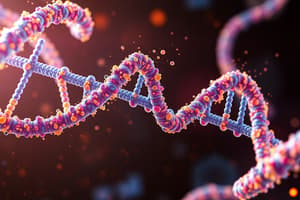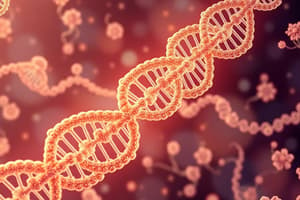Podcast
Questions and Answers
Which of the following is a key distinction between purines and pyrimidines?
Which of the following is a key distinction between purines and pyrimidines?
- Purines include uracil, while pyrimidines include guanine.
- Purines contain a double-ring structure, while pyrimidines have a single-ring structure. (correct)
- Purines are found exclusively in RNA, while pyrimidines are only present in DNA.
- Purines contain a single-ring structure, while pyrimidines have a double-ring structure.
A researcher isolates a nucleotide from a cell. After analysis, the nucleotide is found to contain uracil and a ribose sugar. From this, the researcher can conclude that the nucleotide likely originated from:
A researcher isolates a nucleotide from a cell. After analysis, the nucleotide is found to contain uracil and a ribose sugar. From this, the researcher can conclude that the nucleotide likely originated from:
- A tRNA molecule. (correct)
- A DNA molecule.
- A protein molecule.
- An mRNA molecule.
Which of the following is NOT a function of the minor (modified) bases found in nucleic acids?
Which of the following is NOT a function of the minor (modified) bases found in nucleic acids?
- Providing structural support to the DNA double helix. (correct)
- Oligonucleotide recognition.
- Regulating the half-life of RNAs.
- Protect host DNA from digestion by DNAses.
A mutation in a cell line leads to a defect in the methylation process. Which of the following consequences is most likely to occur due to this mutation?
A mutation in a cell line leads to a defect in the methylation process. Which of the following consequences is most likely to occur due to this mutation?
What type of bond connects a nitrogenous base to the pentose sugar in a nucleoside?
What type of bond connects a nitrogenous base to the pentose sugar in a nucleoside?
Which carbon atom of the pentose sugar is involved in the formation of the N-glycosidic bond with a nitrogenous base?
Which carbon atom of the pentose sugar is involved in the formation of the N-glycosidic bond with a nitrogenous base?
If a scientist discovers a new nucleoside containing a modified guanine base, where is the most likely location for the methyl group?
If a scientist discovers a new nucleoside containing a modified guanine base, where is the most likely location for the methyl group?
Caffeine is a methylated xanthine. Based on the provided information, how many methyl groups are present in a caffeine molecule?
Caffeine is a methylated xanthine. Based on the provided information, how many methyl groups are present in a caffeine molecule?
Which carbon atom of the sugar moiety within a nucleotide is the phosphate group directly attached to?
Which carbon atom of the sugar moiety within a nucleotide is the phosphate group directly attached to?
What is the primary difference between the keto and enol forms of a nitrogenous base?
What is the primary difference between the keto and enol forms of a nitrogenous base?
Why is interconversion between syn and anti conformers of nucleotides generally restricted?
Why is interconversion between syn and anti conformers of nucleotides generally restricted?
Which of the following is the correct pairing of a base, its corresponding nucleoside, and its corresponding nucleotide?
Which of the following is the correct pairing of a base, its corresponding nucleoside, and its corresponding nucleotide?
Which function is primarily associated with purine nucleotides rather than pyrimidine nucleotides?
Which function is primarily associated with purine nucleotides rather than pyrimidine nucleotides?
How do ADP levels regulate oxidative phosphorylation in mitochondria?
How do ADP levels regulate oxidative phosphorylation in mitochondria?
Which of the following nucleotide derivatives is critical for the uronic acid pathway and glycogenesis?
Which of the following nucleotide derivatives is critical for the uronic acid pathway and glycogenesis?
What is the function of S-adenosyl methionine (SAM) in cellular metabolism?
What is the function of S-adenosyl methionine (SAM) in cellular metabolism?
Flashcards
Nucleotide Components
Nucleotide Components
A nucleotide consists of a base, a sugar, and a phosphate group.
Tautomerism
Tautomerism
The shift between keto/enol or amino/imino forms of purines and pyrimidines.
Syn and Anti Conformers
Syn and Anti Conformers
Nucleotides exist in syn and anti conformations, but the anti-conformer is more common.
Adenine to AMP
Adenine to AMP
Signup and view all the flashcards
Guanine to GMP
Guanine to GMP
Signup and view all the flashcards
Nucleotide role in Nucleic Acids
Nucleotide role in Nucleic Acids
Signup and view all the flashcards
ATP and GTP Function
ATP and GTP Function
Signup and view all the flashcards
cAMP and cGMP Role
cAMP and cGMP Role
Signup and view all the flashcards
Nucleotide
Nucleotide
Signup and view all the flashcards
DNA and RNA
DNA and RNA
Signup and view all the flashcards
Nitrogenous Bases
Nitrogenous Bases
Signup and view all the flashcards
Purines
Purines
Signup and view all the flashcards
Pyrimidines
Pyrimidines
Signup and view all the flashcards
Minor Bases
Minor Bases
Signup and view all the flashcards
Nucleoside
Nucleoside
Signup and view all the flashcards
β-N-glycosidic bond
β-N-glycosidic bond
Signup and view all the flashcards
Study Notes
Nucleotide Chemistry Basics
- Purine and Pyrimidine bases, along with their nucleosides and nucleotides, form the building blocks of nucleic acids
- There are two main types of nucleic acids - Deoxyribonucleic acid (DNA) and Ribonucleic acid (RNA)
- The building unit of nucleic acid, i.e. the nucleotide, comprises a nitrogenous base (purine or pyrimidine), a pentose sugar (ribose or deoxyribose), and a phosphate group
Nitrogenous Bases
- These bases have a heterocyclic ring structure containing carbon and nitrogen
- There are major and minor bases according to their abundance in cells
- Major bases are present in large amounts
- Major purine bases: Adenine and guanine are found in both DNA and RNA
- Major pyrimidine bases include: Cytosine (present in both DNA and RNA), Thymine (present only in DNA), and Uracil (present only in RNA)
Minor Bases
- Minor bases are present in trace amounts and are usually methylated, such as 5-methyl cytosine and N7-methylguanine
- Minor bases have important functions involving Oligonucleotide recognition, Regulating the half-life of RNAs, and Protecting host DNA from digestion by DNAses
- Some bases exist in a free state inside cells: Xanthine, hypoxanthine, and uric acid
- Methylated xanthines: Caffeine (1, 3, 7 trimethyl xanthine) in coffee, theophylline (1, 3 dimethyl xanthine) in tea, and theobromine (3, 7 dimethyl xanthine) in coca
Nucleosides
- Nucleosides consist of a base and a sugar (ribose or deoxyribose)
- Sugars are bound to bases via a covalent, β-N-glycosidic bond which links the C₁ of the sugar with N-9 of a purine or N-1 of a pyrimidine
- Numbering of sugar atoms uses a prime to differentiate them from base atoms (e.g., 3' or 5')
Nucleotides
- A nucleotide consists of a base, sugar, and phosphate group
- The phosphate group is attached to the C-5 of the sugar
Tautomerism
- Purines and pyrimidines can exist in two isoforms: keto (or lactam) and enol (lactim) forms, as well as amino (-NH₂) and imino (=NH) forms
- Tautomerism occurs when a molecule changes from one form to another
- Keto and amino forms are common at the physiological pH
Syn and Anti-Conformers
- Nucleotides exist as stable, non-interconvertible syn and anti conformers
- The β-N-glycosidic bond is very stable, restricting rotation around the bond, where Interconversion between conformers requires rupture and reformation of the glycosidic bond
- The anti-conformer is the predominant form
Bases, Nucleosides, and Nucleotides Nomenclature
- Adenine (A) forms Adenosine and Adenosine monophosphate (AMP); Deoxyadenosine and Deoxyadenosine monophosphate (dAMP)
- Guanine (G) forms Guanosine and Guanosine monophosphate (GMP); Deoxyguanosine and Deoxyguanosine monophosphate (dGMP)
- Hypoxanthine (I) forms Inosine and Inosine monophosphate (IMP)
- Cytosine (C) forms Cytidine and Cytidine monophosphate (CMP); Deoxycytidine and Deoxycytidine monophosphate (dCMP)
- Uracil (U) forms Uridine and Uridine monophosphate (UMP)
- Thymine (T) forms Thymidine and Thymidine monophosphate (TMP)
- Xanthine (X) forms Xanthosine and Xanthosine monophosphate (XMP)
Functions of Nucleotides
- Both purine and pyrimidine nucleotides are building blocks of nucleic acids, DNA and RNA
- Purine nucleotides are high energy stores, ATP and GTP, and are intracellular signals like cAMP and cGMP which act as second messengers for many hormones
- Purine nucleotides enter form various coenzymes such as NAD, NADP, FAD, and FMN, which act as hydrogen carriers, and COASH, which acts as an acid carrier
- Purine nucleotides are the active methyl donor (S-adenosyl methionine, SAM), the active sulfate donor (3'phosphoadenosine-5'-phosphosulfate, PAPS), and regulate oxidative phosphorylation rate in mitochondria via ADP levels
- Pyrimidine nucleotides form high energy intermediates, for example, Uridine diphosphate glucose (UDP-glucose), used in glycogenesis and the uronic acid pathway
- Pyrimidine nucleotides serve as high energy stores: CTP and UTP
Studying That Suits You
Use AI to generate personalized quizzes and flashcards to suit your learning preferences.
Related Documents
Description
Explore the essentials of nucleotide chemistry. Learn about purine and pyrimidine bases, their nucleosides and nucleotides, and their role as building blocks of nucleic acids. Understand the differences between major and minor bases, including Adenine, Guanine, Cytosine, Thymine, and Uracil in DNA and RNA.




